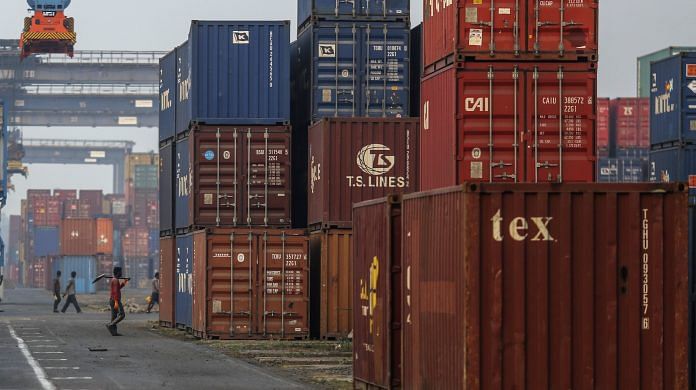Limited diversification, uncertain global conditions, GST and credit crunch badly hurt India’s exports even as rupee depreciated.
New Delhi: India’s exports have begun to show an uptick in the first four months of fiscal 2018-19.
But that’s not the real story. Nor is it something to rejoice over considering the headwinds forecast for the Indian economy.
The story of Indian exports is that they have stagnated for four years until fiscal 2017-18 even though the rupee also depreciated during this period, a development that should have actually spelt good news for exports.
In 2014-15, India’s exports stood at $310 billion, declining 1 per cent from $314 in 2013-14.
The exports further fell 15 per cent to $262 billion in 2015-16.
Only from 2016-17, the sector managed to make a comeback of sorts, registering a 5 per cent growth to $276 billion and then a 10 per cent growth to $304 billion in 2017-18, according to government data.
This came at a time when the rupee weakened against the US dollar.
The exchange rate of the rupee to a dollar was less than 60 in May 2014, when the Narendra Modi government came to power.
It fell to Rs 62.16 to a dollar in April 2015 and further dropped to Rs 66 by April 2016.
A year later, the currency strengthened to an average level of 64 to a dollar.
So far this year, the rupee has taken a huge beating losing 13 per cent, according to official data, earning the tag of Asia’s worst performing currency.
Also read: India’s software exports are not the answer to the rising oil bill
A depreciation of the rupee typically spells good news for the exports sector as it allows higher earnings.
Yet, according to Reserve Bank of India’s 2018 annual report, India’s share in world exports has been constant at around 1.7 per cent in the last five years, “possibly pointing to a protracted stagnation in competitiveness”.
Fall start
Official data shows the start of the fall in 2014-15 was due to a combination of a drop in crude oil prices, difficult global economic situation, and the residual effect of the US financial crisis of 2008 which contracted global trade.
In 2015-16, the fall deepened because of the limited diversification of India’s export basket at a time when growth was already volatile. The top 10 principal exports made up for 78 per cent of India’s total export commodities.
Of these, engineering goods, gems and jewellery, chemicals and readymade garments registered negative or near zero growth rates in 2015-16.
At around the same time, the growth of pharmaceuticals exports collapsed because of increasing competition due to abbreviated new drug applications (ANDAs) being filed with the US Food and Drugs Administration, which reduced the pricing power of Indian exporters.
Continuous struggle
Further, a cash crunch due to thinning of credit, the demonetisation exercise in November 2016, uncertain global conditions and the immediate problems arising out of the goods and services tax (GST) in 2017 led to a slowdown in the export sector, which despite the gradual slide of the rupee, was unable to cash in.
Also read: Trade wars & cash crunch threaten to muzzle India’s animal spirits
The slowdown of the sector in 2017-18 was widely blamed on GST implementation starting in July 2017. This led to many bottlenecks for exporters to get their refunds on good and services exports.
“We have seen that when GST was imposed, the returns were not coming back smoothly,” Bimal Jain, chairman of the indirect tax committee at PHD Chamber of Commerce, told ThePrint.
“The government is trying its best to improve upon the mechanism and make sure that these returns take place in time bound manner, because a lot of money is still held up in repayment on exports of goods and services.”
GST refunds of about Rs 20,000 crore are still stuck.
Recently, many banks have also shared the details of those exporters who have not yet received the payments against the shipment of their goods with the Enforcement Direcorate, hoping it will bring back foreign currency in India.
Recovery
The rupee is also depreciating because of discrepancy in the recovery of money in a timely manner for the exports that are being made, said Jain.
“If I export a good, I get the invoice, but I must also get the money back from the recipient within the specified time period. If I’m not getting my money back in time, which is convertible foreign exchange, then I’m lacking in enough convertible US dollar to support the rupee’s position,” he said.
Experts also point to infrastructure stagnation as a major contributor to the slowdown.
“Our export processing infrastructure is already at peak use and has begun to stagnate. For example, ports and railways are massively costly to operate, and there is inefficiency which adds to problems,” Rajesh Chakrabarti, professor and acting dean of Jindal Global Business School, told ThePrint.
“The waiting time of ships at ports, and for border-crossing for goods export are factors that have now begun to weigh in more than before, we are going through a supply constraint.”




As long as Ambani’s and Reliance Subsidiaries (everyday new ones are formed in every field of government where money can be made in millions and above) & other such are minting money, it is not a disaster. If you question in any more detail you are anti-national.